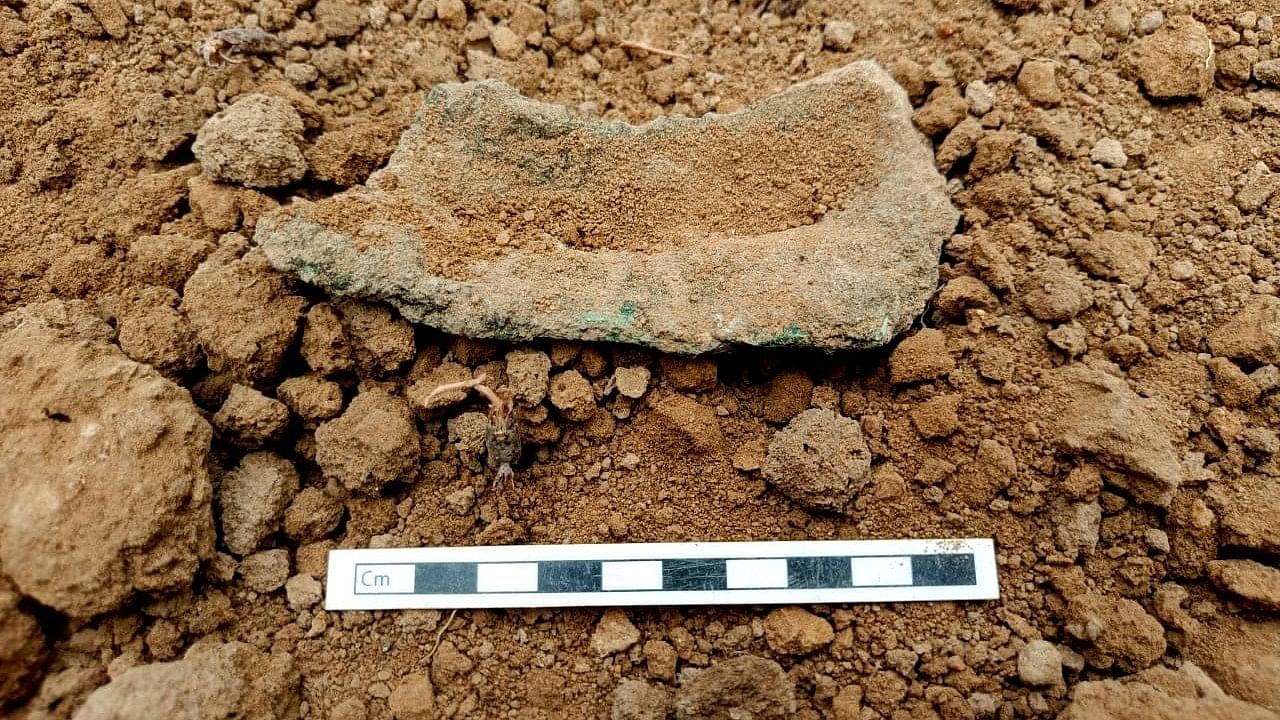
One of the postherds excavated from Keeladi, a Sangam-era urban settlement site on the banks of river Vaigai in Madurai, Tamil Nadu.
Credit: Special Arrangement
Chennai: It has been an exciting week for archaeologists in Tamil Nadu with the recovery of two potsherds adorned with fish motifs, copper objects, copper coin, a flint seal, and hundreds of antiquities from sites where excavations were launched on June 18.
In the previous week, archaeologists unearthed a potsherd with the Tamil letter 'Tha' inscribed on it from Keeladi, a Sangam-era urban settlement site on the banks of river Vaigai in Madurai, a broken Neolithic hand axe and a terracotta female figurine from Chennanur in Krishnagiri district and Vembakkottai in Virudhunagar district respectively.
On July 1, two potsherds adorned with fish motifs were discovered at depths of 58 cm and 96 cm respectively from one of the trenches in Keeladi, in a significant finding.
These fish figures are exquisitely marked on Red Slipped Ware and the dimensions of these engraved potsherds, found partially broken, measure 4 cm by 5 cm and 4 cm by 3 cm in length and width respectively, a senior official with the Tamil Nadu State Department of Archaeology (TNSDA) said.
Credit: Special Arrangement
On Wednesday, the archaeologists found broken copper objects from a depth of 111 cm at Keeladi.
The first two weeks of excavation in Keeladi has also resulted in the recovery of over 100 antiquities, beads, spindle whorls, and hopscotch, besides heaps of potsherds. Keeladi, 12 km southeast of Madurai where excavations first began in 2014, bores enough evidence of an urban industrialised settlement, with carbon-dating of artefacts from the site establishing its age to be 2,600 years old.
The official said a copper coin from the period of the famed Chola Kingdom, who established trade ties with China, was recovered from Marungur in Cuddalore district. The coin measures 23.3 mm in diameter, 2.5 mm in thickness and weighs 3 grams, the official added.
In Sennanur in Krishnagiri district, archaeologists recovered neolithic stone tools, flint seals, pieces of conch bangle, round chips, and glass bangle pieces this week, while an iron plough-head was found at a depth of 75 cm in an excavation pit.
Credit: Special Arrangement.
"The weight of this head is 1.292 kg. It measures 32 cm in length, 4.5 cm in width and 3 cm in thickness. This tip may have been used as a tip in an air plough for farming in ancient times. Given the archaeological context in which this object was found, it may be dated to the medieval period", the official said.
A flint seal has been found in the Chennanur excavations. This seal measures 4.5 cm in length and 3.2 cm in diameter.
The excavations come at a time when such exercises have started to a buzz after throwing up surprises since the past few years. Artefacts unearthed in Keeladi pushed the Sangam Era to 600 BCE from 300 BCE, rice husks found in a burial urn in Sivakalai was found to be 3,200 years old, and that Tamils were aware of iron technology in 2172 BCE - about 4,200 years ago.
The carbon dating pushed the Sangam Era by three hundred years that it was thought to be. The Archeological Survey of India, which conducted the first two phases of excavation, also derived the period of the Sangam-era archaeological site to be between 8th century BCE to 3rd century CE.
These findings come amidst repeated assertions by Chief Minister M K Stalin that his government will take every step to scientifically prove that India’s history will have to be rewritten from the Tamil landscape, in the light of findings in Keeladi and Sivakalai.